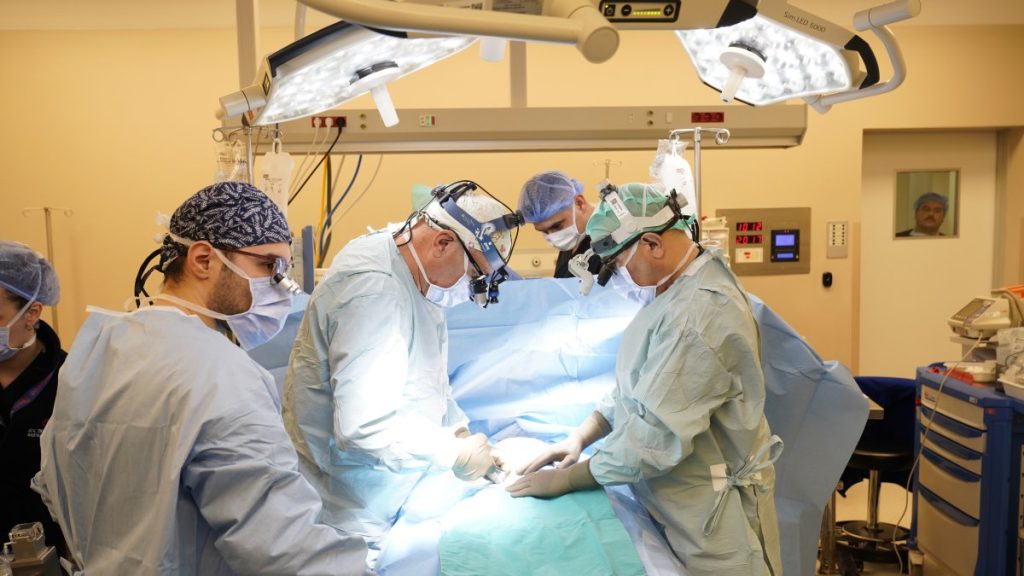Born with a rare and complex heart condition known as Topsy-Turvy syndrome, 5.5-year-old Fatma Nur Yolaldı has become only the second known patient in the world to survive after undergoing a groundbreaking surgery that corrected her heart’s abnormal position and relieved pressure on her lungs.
Fatma Nur entered the world with her heart lying horizontally across her chest, an extremely unusual position that caused the main artery supplying her lungs to be compressed.
This compression led to the complete failure of her left lung last year, putting her life at serious risk. Though surgery was necessary to save her, the operation was deemed too dangerous, and no hospital in Türkiye was willing to perform it.
That changed when a team led by Professor Dr. Afksendiyos Kalangos, head of Pediatric and Congenital Cardiovascular Surgery at Koç University Faculty of Medicine, and surgeon Dr. Yılmaz Zorman undertook the unprecedented procedure in Türkiye, bringing the young girl back to health.
During the surgery, her body temperature was lowered to 20 degrees Celsius (68 degrees Fahrenheit) to minimize risks, while the artery compressed by her heart was replaced with an 11-centimeter (4-inch) vessel harvested from a donor. This delicate reconstruction restored proper blood flow. Her case will now be recorded in medical literature as the second worldwide to survive this rare syndrome following such an operation.
Fatma Nur is the second child of Fadile and Mustafa Yolaldı, residents of Ankara. Beyond the Topsy-Turvy syndrome, she was also born with an extremely rare anomaly – a hole between the walls of the artery feeding her lungs and the aorta, the main artery that distributes blood throughout the body.
Her health journey began with a critical surgery at 30 days old to close this hole. But by age 1, her heart’s abnormal horizontal placement, almost rotated 90 degrees, caused increasing breathing difficulties.
The compressed artery feeding her lungs worsened, and despite interventions such as a stent placement to open her airways, her left lung became permanently damaged, effectively shutting down.
For the next four years, Fatma Nur’s life was spent moving between hospitals, her condition deteriorating as her right lung also faced a threat due to the pressure exerted by the misplaced heart. The only hope was a complex surgery to reposition the arteries, a procedure never before performed in Türkiye.
The family reached out to Dr. Kalangos, who is internationally recognized for handling the most challenging heart cases.
“Without surgery, she would have died,” said Kalangos. “The Topsy-Turvy syndrome is severe. Normally, the heart sits at an angle, but Fatma Nur’s heart was completely horizontal, squeezing the two large arteries feeding the lungs behind and below it.”
He added: “There was also a second congenital heart defect, an aortopulmonary window, a rare hole between the main arteries that had been closed when she was a month old. But her breathing worsened after six months, and the left lung suffered greatly.”
Explaining the operation, Kalangos said: “Her clinical condition meant we had to act. The only hope was to create a new artery to relieve pressure and save the right lung – which meant saving her life. We performed a complex surgery, cutting and repositioning the artery, creating a new aortic arch by extending it into the left chest cavity. We used an 11-centimeter donor vessel. Unfortunately, the left lung was too damaged by infection and had to be removed entirely.”
“This was the first successful surgery of this kind in Türkiye. We applied rare surgical techniques, including cooling her body to 20 degrees Celsius (deep hypothermia) to prevent brain damage during the operation. We spent days in the hospital waiting and hoping. Even holidays were spent there as a team,” Zorman added.
For Fatma Nur’s mother the journey has been one of heartbreak and hope. “At 4.35 months pregnant, the detailed ultrasound showed the heart abnormality. We were told the syndrome was one in a million and survival would be extremely difficult.”
“Doctors warned us to prepare for the worst. We spent 40 days in the hospital after her birth. Until 1 year old, she did well, but then breathing problems began. We were told she wouldn’t reach 4 or 5 years old. We knocked on every door, but no hospital accepted the surgery because it was too risky,” she added.
“She couldn’t breathe properly and couldn’t even play outside. Now we’re eagerly waiting for her to start school. We hope our story gives hope to others. It’s like she has had two miracles,” she said.


